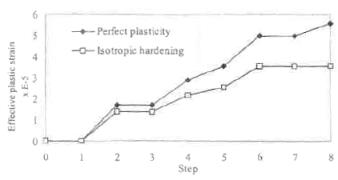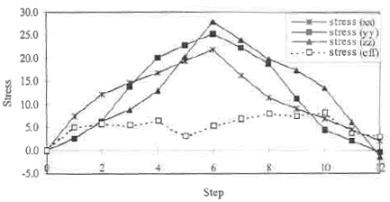Static Analysis with Plasticity Problems
This chapter contains a static analysis with elasto-plastic behaviour in which the structure is loaded past the yield point.
This chapter contains the following models:
mvspl001 : Small Strain Elasto-Plastic Analysis of Square Plate
|
Analysis Type:
|
Small Strain Elasto-Plastic Analysis
|
|
Model Type:
|
2D Plane Strain
|
|
Comparison:
|
NAFEMS Benchmark
|
|
Reference:
|
Fundamental 2D Plasticity Benchmark, Understanding Non-linear Finite Element Analysis through Illustrative Benchmark,NAFEMS, pp. 31.
|
|
Description:
|
The problem consists of a simple 2D geometry subjected to prescribed displacements in order to demonstrate plastic behavior.
|

Specifications
Element Type: | 2D Solid | |||
Units: | mmNs | |||
Dimensions: | L: 1.0 Unit length | |||
Material Properties: | Mass Density: 0 Young's Modulus: 2.5e5 | Poisson's Ratio: 0.25 Plasticity Model: 1. Perfect Plasticity—Yield Stress : 5.0 2. Isotropic Hardening—Tangent Modulus :5e4
| ||
Constraint | Location | Degree of freedom | ||
Placed on edge AD | Translation along X- fixed | |||
Placed on edge AB | Translation along Y- fixed | |||
Placed on edge BC | TransX-: 2.5e-5 | |||
Placed on edge CD | TransY-: 2.5e-5 | |||
TransX and Trans Y are applied in 8 steps as follows (R=TransX=TransY) | ||||
Step | TransX | TransY | ||
Step 1 | R | 0.0 | ||
Step 2 | 2R | 0.0 | ||
Step 3 | 2R | R | ||
Step 4 | 2R | 2R | ||
Step 5 | R | 2R | ||
Step 6 | 0.0 | 2R | ||
Step 7 | 0.0 | R | ||
Step 8 | 0.0 | 0.0 | ||
Comparison of Results Data
Stress Variation per load step for | NAFEMS | Structure |
|---|---|---|
Perfect Plasticity |  |  |
Isotropic Hardening |  |  |
Effective Plastic Strain Variation per load step for 1. Perfect Plasticity 2. Isotropic Hardening |  |  |
mvspl002 : Small Strain Elasto-Plastic Analysis of 3D Cube
Analysis Type: | Small Strain Elasto-Plastic Analysis |
Model Type: | 3D |
Comparison: | NAFEMS Benchmark |
Reference: | Fundamental 3D Plasticity Benchmark, Understanding Non-linear Finite Element Analysis through Illustrative Benchmark,NAFEMS, pp. 39. |
Description: | The problem consists of a simple 3D geometry subjected to prescribed displacements in order to demonstrate multi-axial plastic behavior. |

Specifications
Element Type: | 3D Solid | ||||
Units: | mmNs | ||||
Dimensions: | L: 1.0 | ||||
Material Properties: | Mass Density: 0 Young's Modulus: 2.5e5 | Poisson's Ratio: 0.25 Plasticity Model: 1. Perfect Plasticity—Yield Stress : 5.0 2. Isotropic Hardening—Tangent Modulus :5e4
| |||
Constraint | Location | Degree of freedom | |||
Placed on face AEHD | Trans X- fixed | ||||
Placed on face ABFE | Trans Y- fixed | ||||
Placed on face ABCD | Trans Z- fixed | ||||
Placed on face BCGF | TransX: 2.5e-5 | ||||
Placed on face CDHG | TransY: 2.5e-5 | ||||
Placed on face EFGH | TransZ: 2.5e-5 | ||||
TransX,TransY, and TransZ are applied in 12 steps as follows (R=TransX=TransY=TransZ) | |||||
Step | TransX | TransY | TransZ | ||
Step 1 | R | 0.0 | 0.0 | ||
Step 2 | 2R | 0.0 | 0.0 | ||
Step 3 | 2R | R | 0.0 | ||
Step 4 | 2R | 2R | 0.0 | ||
Step 5 | 2R | 2R | R | ||
Step 6 | 2R | 2R | 2R | ||
Step 7 | R | 2R | 2R | ||
Step 8 | 0.0 | 2R | 2R | ||
Step 9 | 0.0 | R | 2R | ||
Step 10 | 0.0 | 0.0 | 2R | ||
Step 11 | 0.0 | 0.0 | R | ||
Step 12 | 0.0 | 0.0 | 0.0 | ||
Comparison of Results Data
Stress Variation per load step for | NAFEMS | Structure |
|---|---|---|
Perfect Plasticity |  |  |
Isotropic Hardening |  |  |
Effective Plastic Strain Variation per load step for 1. Perfect Plasticity 2. Isotropic Hardening |  |  |